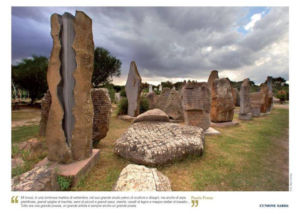Project Description
Nearly 200 centuries after the Romans, Sardinia’s most famous sculptor, Pinuccio Sciola, showed his understanding of the essence of nature: “If we pay attention to it, stone will delight us with its tune: stone hides the sound of water within itself.” The Sounding Stones indeed resound, once polished by hand or with small rocks. The sonic properties of the sculptures are made by applying parallel incisions on the rock. These sculptures are able to generate a variety of structured sounds, with differing qualities, depending on the density of the stone and its engraving: sounds reminiscent of glass, metal, wooden instruments and even human voices. And we may view one of Pinuccio Sciola’s othe sculptures as well (in the picture below: Pinuccio Sciola and Renzo Piano)

If you choose a special visit, we can fly to Sciola’s atelier on the island of Sardinia, to see his garden of wonderful sculptures, including the Sounding Stones, and attend a jazz concert played on these instruments.

Pinuccio Sciola’s Sounding Stones are exhibited all over the world, including concerts using them as the real musical instruments they are. They are a source of inspiration for artists, musicians and composers. Sadly, Pinuccio passed away last year, but he left many Sounding Stone sculptures throughout the world. Renzo Piano decided to set one of these Stones in the Auditorium, as a tangible sign that nature is the foundation of culture. If you opt to remain in Rome, you will attend a wonderful jazz concert showcasing the Stones, or, if you decide to visit the sculptor’s home.

Leave A Comment